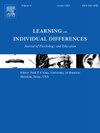Investigating the effects of linguistic distance on German and English reading and mathematics among fifth-graders in Germany
IF 3.8
1区 心理学
Q1 PSYCHOLOGY, EDUCATIONAL
引用次数: 0
Abstract
Multilingual classrooms are becoming more common around the globe following increased migration and mobility. Multilingual learners have to overcome potential language barriers across the curriculum as the majority language remains the point of reference for learners across subjects. Analytically, multilingualism is often mapped in terms of categories (L1/L2), but a linguistic distance can provide additional information for teaching practice. Little research has considered the impact of linguistic distances from students' L1s to the language of instruction and foreign languages, particularly in immigrant language contexts.
This study investigates how linguistic distances affect German L1 speakers and multilingual learners' (Lx) (N = 3,307) attainment of German reading, English reading, and Mathematics in grade 5. We used mixed-effects models to examine the role of linguistic distance while rigorously controlling for individual learner characteristics focused on language and students' socioeconomic status, including sex, multilingual status, born abroad, cultural capital, own room, own computer, and household income.
Results suggest that lexical linguistic distance is a significant factor in predicting German and English reading scores as well as Mathematics achievement. Pedagogical implications and considerations to bridge linguistic distances are discussed.
Educational relevance statement
Classrooms worldwide are increasingly diverse concerning languages and cultures represented in the student body. Educators and researchers alike still categorize students into two groups: native and non-native speakers. However, the latter group is highly diverse. Linguistic distance measurements enable us to investigate the association of language differences to the language of instruction and break apart the two groups. The more distant the family language is from the language of instruction, the more pronounced the disparities become. The results demonstrate that linguistic diversity is not addressed adequately, with implications for teacher training and professional development as well as curriculum development.
调查语言距离对德国五年级学生德语和英语阅读及数学学习的影响
随着移民和流动性的增加,多语言课堂在全球范围内变得越来越普遍。多语种学习者必须克服课程中潜在的语言障碍,因为多数人的语言仍然是各学科学习者的参照点。从分析的角度看,多语制通常是按类别(L1/L2)来划分的,但语言距离可以为教学实践提供更多的信息。本研究调查了语言距离如何影响以德语为母语者和多语言学习者(Lx)(人数=3307)在五年级的德语阅读、英语阅读和数学成绩。我们使用混合效应模型来研究语言距离的作用,同时严格控制学习者的个人特征,重点是语言和学生的社会经济地位,包括性别、多语言地位、在国外出生、文化资本、自己的房间、自己的电脑和家庭收入。结果表明,词汇语言距离是预测德语和英语阅读成绩以及数学成绩的重要因素。研究结果表明,词汇语言距离是预测德语和英语阅读成绩以及数学成绩的重要因素,并讨论了弥合语言距离的教学意义和注意事项。教育工作者和研究人员仍然将学生分为两类:母语学生和非母语学生。然而,非母语学生群体具有高度的多样性。语言距离测量使我们能够研究语言差异与教学语言的关联,并将两个群体区分开来。家庭语言与教学语言的距离越远,差异就越明显。结果表明,语言多样性问题没有得到充分解决,这对教师培训、专业发展和课程开发都有影响。
本文章由计算机程序翻译,如有差异,请以英文原文为准。
求助全文
约1分钟内获得全文
求助全文
来源期刊

Learning and Individual Differences
PSYCHOLOGY, EDUCATIONAL-
CiteScore
6.60
自引率
2.80%
发文量
86
期刊介绍:
Learning and Individual Differences is a research journal devoted to publishing articles of individual differences as they relate to learning within an educational context. The Journal focuses on original empirical studies of high theoretical and methodological rigor that that make a substantial scientific contribution. Learning and Individual Differences publishes original research. Manuscripts should be no longer than 7500 words of primary text (not including tables, figures, references).
 求助内容:
求助内容: 应助结果提醒方式:
应助结果提醒方式:


